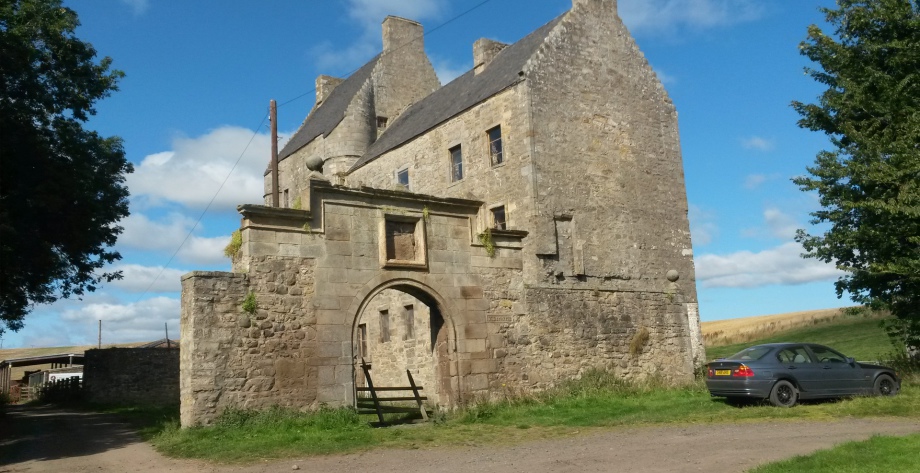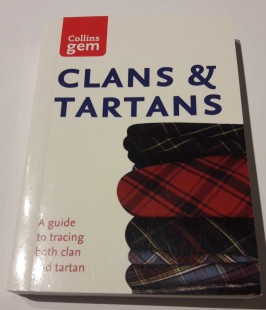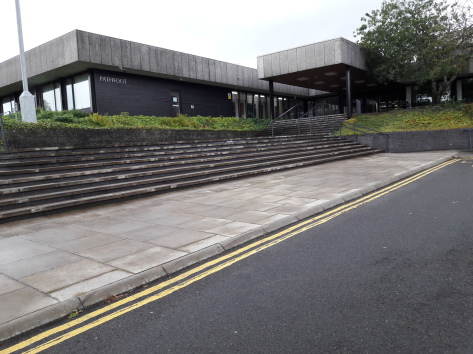
Sunday, September 9th - Doune, Stirling and Dunblane
On Sunday morning, after another breakfast at Tinderbox, we headed back to the northeast, about the same route as the day before, towards Stirling, but our first station of the day was Doune. In the small village, next to the castle where they shot for Castle Leoch, Terry Dresbach lived until only a few months ago, most likely with Ronald D. Moore, her husband and producer of the series, and two dogs.
And so I showed my fellow travelers the entrance to Terry's house, of course we didn't go in, it's private and it would've made no sense, she doesn't live there anymore, otherwise she wouldn't have posted it on Twitter. But it was on our way, right next to the driveway to Doune Castle, which was used in the series to represent Castle Leoch, Clan McKenzie's headquarters. Here we finally redeemed the vouchers for our Explorer Pass, which was quite a bit of bureaucracy and took its time, we also got headsets, to Karin's and Conny's disappointment there were only available in English language. But I could give them something to look forward to; what I like about it each time I come to Doune, some of the explanations of the castle, those about Outlander shooting locations, are spoken by Sam Heughan with his incredibly charming voice. Unfortunately there was still a large scaffolding in the inner courtyard, no visible progress of the construction work, even on the top of the weir, apparently nothing had changed since my visit last year. With Conny and Katrin, I visited the different rooms, translated some of the English explanations for them into German and was happy again about Sam's wonderful eludications about what it had looked like during the shooting and how he got access to his role through the Gaelic language, which he didn't speak before. The courtyard of the Castle had been completely covered with earth and mud by the production team. In front of the castle, a lot of tents were standing, with cooking kettles, sheds and other structures, a whole village was built, and on the meadows behind the castle, the Shinty game (similar to nowaday's hockey) took place. Most of the players were real shinty players and played really hard, Sam and Graham McTavish (Dougal) didn't just play easy, on the contrary, they fought hard and both suffered a lot of wounds. When they shot the scene with Jamie's and Claire's arrival on Castle Leoch, it was really, really cold, the production team wore thermal underwear, he wore, well, his kilt and Catriona (Claire) just a thin shirt.
We admired particularly the huge castle kitchen, which I was able to report had been completely rebuilt true to scale for filming in the studios in Cumbernauld, otherwise they would have been afraid of damaging the original kitchen.
And in the last room in the basement I finally discovered why so few items were offered for sale in the cash room: they had redesigned an entire cellar room into a souvenir shop! So we could endulge in the whole Outlander fan world, we found postcards, a great leather jug and a book with all clans and tartans, and we also got a nice map from visitscotland.com with all locations of season 1-3, one map for each girl of our group.
And before we left castle grounds, we met a real Scotsman in a traditional kilt, truly something very special, as you see more often the more modern kilt with tightly sewn folds, more like a kind of a pleated skirt for men. If you ask people friendly, they never mind being photographed, they are proud of themselves and how they present themselves and their dresses.
In this gift shop, I bought myself this small book "Clans & Tartans" which explains for each clan it's tartan, crest badge and motto as wel as some explanations of the history of said clan. Very informativ!
Next we went on to Stirling Castle, a few miles northeast of Doune. The old town and the castle are located on a volcanic ridge, so the road uphill was really steep. Again we found ourselves a nice disabled parking place near the entrance and once we were in, we could easily join a tour that had started shortly before, only unfortunately but in English again. So I translated the details when necessary and we walked from the lower battery up into the courtyard in front of the Palace, the Great Hall and the castle chapel. The outer facade of the Great Hall is currently being extensively renovated and therefore scaffolded, but the authentic color, according to our guide, was not orange, apricot or yellow, but - royal gold, each one who dared to say something different puts his head on the scaffold! The Great Hall with its imposing wooden ceiling made of massive oak beams is very impressive, built without a single nail, only with wooden foundations. You can still smell the fresh smell of wood nowadays. Where there are curtains on the walls today, there used to be wall hangings and carpets, a trumpeter used to stand on the upper side of the small gallery at festive events, and when Her Majesty the Queen was here for a banquet a few years ago, they picked that up and welcomed her from there by a trumpeter in authentic style. The chapel can theoretically be rented for a wedding, but the costs are at least in the six-figure range. Here our guide ended his tour with some good advice for the rest of the way and dismissed us into the rest of the castle.
We went to the palace area that had been renovated over the last few years in a complex and historically very authentic way. They celebrated the year 1542, when King James' V. and his wife's Marie de Guise (from France) heir to the throne baby Mary was born, the later called Mary Queen of Scots (in Germany called Maria Stuart), with some kind of reenactment. In the Queen's rooms, we met a young lady in royal robes who represented the Queen Marie de Guise for us the palace visitors. She was just saying goodbye to a group of Spanish tourists in Spanish and I addressed her in German, just for fun, whereupon it turned out that this was one of five foreign languages she spoke well and fluently! With her royal elegance, she was just the right person for the role she impersonated, entertaining changing audiences all day long and dignifiedly telling about the Queen's life. I already knew her from my previous visit last year, when she had impersonated a Queen's court lady and wore a corresponding dress, whereupon we had an interesting conversation about Renaissance costumes. Marie de Guise and the king did have a rather unusual relationship at that time, because there was serious affection between them, not very common amoung royals. After a compulsory marriage and the early death of his first wife, the king had married a Frenchwoman who did not come from the high nobility but from a very wealthy merchant family and who supported him financially as well as with some good advice and best relations. We could hardly leave the young actress, our conversation was so stimulated and nice, but at some point we had to go on and met the actor of the royal administrator in the next room, the Earl of Arran, who after the early death of Maria Stuart's father, only a few days after her birth, ruled Scotland on her behalf. We were also allowed to admire his robe.
In the lowest-lying part of the castle, there is a carpet museum, where carpets, old motifs and the production are demonstrated. To her enthusiasm, Conny discovered a historical carpet motif, of which she owns a replica amongst her medieval dquipment and now she knows where it originated.
After a visit to the souvenir shop and the café as well as some last pictures high up from the mountain down to the wide landscape, we set off towards the Wallace Monument. Sabine took a small detour for a short look at the Church of the Holy Rude next to the castle. In this context, "Rude" does not mean rude or coarse, but it means the wood of the cross of Christ. At this place, Mary Stuart's son James was crowned king.
The town house Argyll's Lodging a little below the castle, which also belongs to the Explorer Pass locations and is very well worth seeing, was unfortunately shot at times.
The Wallace Monument a monument to Scotland's famous fighter for liberty and indipendency, William Wallace, and is only about 1 mile airline distance from the castle, on a steep hill and consists mainly of a 67 m high tower with a museum. There is a free and sufficient visitor parking place at the foot of the mountain, from which a shuttle bus constantly goes up and down to the monument, this one is also for free and the driver started immediately after we got in. The ground floor of the monument is also free of charge, only those who climb the tower and visit the rooms upstairs have to pay the entrance fee. But we were already very satisfied with the view from the viewing platform over the whole city of Stirling and nobody wanted to take an effort in the ascent with 246 steps. On the small meadow next to the building, two actors in historical costumes depicted some scenes around the famous battle at Bannockburn that William Wallace won for the Scots. Meanwhile the weather became more and more stormy and rainy, Christina and Karin said goodbye first with the shuttle bus downwards, the rest of us stayed until the end of the demonstration and defied the meanwhile very stormy and wet weather until we got a place on the next shuttle ride downwards.
We drove a bit further, until I could show my friends the Pathfoot Building of the University of Stirling, where they had shot on the steps and interior with Brianna, Roger and Geillis for the last episode of season 2. Built in 1967 as the first part of Stirling's new university, it was an ideal location for the late 1960s and early 1970s.
After a few pictures we drove on to Dunblane Cathedral a few kilometres west, a beautiful old church that had been extensively restored a few decades ago - and in which unfortunately it had not been filmed, as the guide on duty assured us credibly despite my persistent demand. But even so, the church is a small piece of jewelry, especially the beautiful woodcarvings in the retirement room and at the organ that we liked very much.
Next we drove a bit back to the ruin of Cambuskenneth Abbey, to which Sabine had discovered a sign a while before. It lies on the outskirts of Stirling at a small stream loop. Founded around 1140 by King David I, abandoned after the Reformation and most of its stones used elsewhere as building material, actually an outrage. Also called Stirling Abbey. Today, there are only knee-high ruins, the bell tower, where one could go to the ground floor and the former church portal, which today is the entrance to the cemetery.
Touch House near Stirling stood for Culloden House during the shooting, both from the inside and from the outside. Unfortunately, you can only get inside if you rent the building or at least pay a huge amount for it. But from the outside it is already very impressive, just imagine tents and camps of the Highland Army in front of it.
On our way south, just by hazard, we passed the Bannockburn Battlefield Monument and since I had only passed it last year (for time reasons), we spontaneously decided to make a short stop for a few photos. The footpath to the Memorial was a bit longer than expected, with the Robert the Bruce equestrian monument outside and the concrete circle next to it, with the flagpole in the middle, on the grounds of the battle where over 700 years ago, the English suffered a humiliating defeat on the hands of the Scots.
On the way back to Glasgow we stopped at the Outlander Wardpark-Studios in the industrial area of Cumbernauld. It was only for a short photo from outside, you can't get in, otherwise I would have booked us a studio tour.
Then we went to the restaurant Rab Ha's in Glasgow, which is only a few meters from our apartment in a side street, Hutcheson Street. We ate well, some more, some less satisfied, but we had a lot of fun together and with three nice young waiters...



















